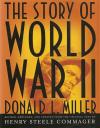Boekenkast

Story of World War II, The
Auteur | Henry Steele Commager, Donald L. Miller |
Eerste Uitgave | 2001 |
Uitgave | 2001 |
Uitgeverij | Simon & Schuster |
Vorm | non-fictie |
Taal | Engels |
Bladzijden | 704 bladzijden |
Gelezen | 2004-02-14 |
Score | 7/10 |
Inhoud
Revised, expanded, and updated from the original text by Henry Steele Commager. A must read for everyone The Story of World War II is an elaborate narrative of 700 pages describing events that happened during the big war. But be not misguided by the title: the focus of the authors is not as broad as the title promises. The book clearly covers the war seen through the eyes of Americans, whereas typical European events are only briefly mentioned. For example the activities of the European resistance and the horror of the German extermination camps are described in but a few lines, where the war around Japan is covered in numerous chapters. This is not a negative critique, because it is humanly impossible to cover every aspect of the war in one book, but just a warning that the title might be misleading. A better title would have been: Americans in World War II. This book is a must read for everyone, because when these memories die, the same terrible mistakes could be made again.
The Story of World War II is a completely rewritten, expanded, and updated version - more than 75 percent new - of the classic narrative of the war that captures all the immediacy of the original work and contains hundreds of new firsthand accounts.
In late 1945, Henry Steele Commager finished a history of World War II that he had begun writing even while the fighting raged. Commager had worked as a propagandist and historian for the U.S. Department of War, and in his book he collected eyewitness descriptions of the fighting by outstanding correspondents, including Ernie Pyle, John Steinbeck, and Martha Gellhorn.
But Commager's history could only be preliminary because many documents and official records had not yet been made available. Today we know much more about World War II, and it is possible to place the war in its proper historical context. Yet, despite the large number of books published about various aspects of World War II, surprisingly few general histories of that war have been attempted in recent years. Inspired by the power of Commager's long-out-of-print volume, historian Donald L. Miller has written a thorough, up-to-date, and riveting account of World War II, from the German blitzkrieg into Poland to the Japanese surrender aboard the U.S.S. Missouri. He provides new coverage of, among other topics, the war in the Pacific, the air war, the liberation of the death camps, and the contributions of African Americans and other minorities. All of the major events of the war are covered, but soldiers, sailors, and airmen and their stories of the fighting predominate. Consequently, this book has a dynamism and authority that no other general history of the fighting can convey.
Miller shares Commager's conviction that World War II was a war of good against evil, but, as he says, it was more than a heroic crusade
Mixed in with valor was cruelty
The Story of World War II contains more than 130 photographs and 22 maps.
Bespreking
That said, The Story of World War II is a brilliant piece of historical work. The set-up of the book is really refreshing: not the historians are telling what did happen, but real witnesses tell their story. Of course everything is weaved together is a correct historical context, but still the real-life reports predominate the book. Not a few times this actually gives the reader a more realistic idea of what human sacrifices where made during that terrible episode of human history. The suffering is at its most vivid in the descriptions of the Japanese prison camps and the attack on the island of Midway. The witness reports from soldiers caught in a capsized war ship during the attack on Pearl Harbor, will be engraved in any reader's memory.